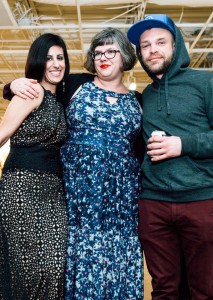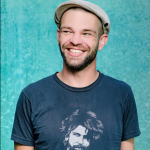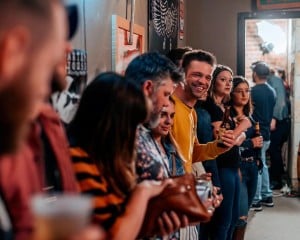Remembering Jeremy Joel: Artist, Friend & Father
ArtandSeek.net June 10, 2020 32Jeremy Joel was a self-made man.
In less than a decade, the outsider folk artist taught himself to paint and made a name for himself as one of Fort Worth’s most promising talents.
The city’s art community is still processing his death. He was found in his apartment on May 29. The cause of death hasn’t been disclosed. He was 37.
Joel was a street artist, well-versed in graffiti, before he turned his attention to the canvas.
He first started painting with the F6 Gallery Collective in 2007.
“He would paint something, then he’d cover up most of it,” Shasta Haubrich says.
Haubrich helps run Art Tooth in Forth Worth, and she’s a close friend of Joel.

Jeremy Joel with Lauren Childs (left) and Shasta Haubrich. Photo by Walt Burns, courtesy of Jeremy Joel and Fort Works Art
“He just kept layering and layering and layering and adding imagery on top of imagery.”
By 2009, that distinctive style started appearing on murals all over Fort Worth. Joel had also started building a community of collaborators, including fellow painter Jay Wilkinson.
“We definitely set each other’s fire,” Wilkinson says. “Any doubt that we had, the other person would be like ‘Nope, we’re gonna do it.’”
Joel’s creative generosity made him a champion for other self-made artists. He created a gallery space, Bobby on Drums, with Wilkinson and artist Brandon Pederson. In 2017, he founded another space, the SAM Gallery, where he curated shows with local artists.
Lauren Childs is the owner of Fort Works Art, which represented Joel as an artist in recent years.
“Many of the unknown artists that we’ve shown were Jeremy’s recommendation,” Childs says. “A lot of these artists don’t have degrees or experience, so most galleries won’t touch them.”
For Joel, defying art world convention was par for the course, and that was most evident in his work.
“Most of his paintings revolve around some kind of story because he would always tell stories,” Haubrich says. “I can’t think of a single one that’s proper for public consumption, but he always had these funny stories.”
His paintings — rough, vibrant and ever-changing — offered glimpses into his life. Joel would cover his canvas with layer upon layer of paint, revealing and concealing as much of himself as he saw fit.
“He would always include the bus routes he would take, things people said to him, the address to homes he lived at or phone numbers,” Wilkinson says. “All those places and all those moments that he had.”
Joel’s family was a recurring theme in his work. Paintings like “Ghost” explore Joel’s relationship with his father, Greg Joel.
“It’s two men in a boat fishing,” she says. “It was a quiet painting. It was a sad painting. It was a hopeful painting. He definitely explored his family a lot in his work.”
His own children — Baillie, Lucas, and Isabella — also made frequent appearances. Joel would place a little piece of them in everything he did.
Childs says his desire to make great art was fueled by his love for his children.
“He always wanted to be a better father,” Childs says. “I want to make work, and I want to be an inspiration to my kids. I want them to see that you can come from nothing and create something enormous and magical.”
Joel’s playful aesthetic in some ways offset the often intense subject matter of his work. Many of his paintings documented his experiences with poverty and addiction.

Jeremy Joel working on a piece from his first solo show, “A Beatbox Caviar.” Photo courtesy of Jeremy Joel and Fort Works Art
“I wanted him to do more of the story scenes, but they were hard for him because they were about such heavy content,” Childs says, “Like growing up with addiction, growing up without money, growing up struggling, growing up without a lot of support as an artist, growing up as a young father.”
His friends say that, despite the many hardships in his life, Joel was kind and deeply caring.
“Most of the time that I interacted with him, anywhere I was, he just kind of made you feel like you belonged there,” Haubrich says.
Joel extended that kindness to everyone, and he always came to bat for Fort Worth’s artists. Pass the Peas, the biannual art show Joel helped organize, attracts artists from all over the country to the city.
He was also making strides in the commercial art world outside of Fort Worth.
In 2017, he showed and sold his work at SCOPE as part of Art Basel Miami, and the following year, Joel mounted his first solo show “A Beatbox Caviar” at Fort Works Art.
“He was full of a lot of highs and a lot of lows,” Childs says. “He experienced the full range of emotions. I used to describe Jeremy as someone who squeezed all the juice out of a lemon.”
The local art community has felt Joel’s absence deeply, but those “enormous and magical” works he created have left an indelible mark on Fort Worth.
Note: Fort Works Art is working to catalog Joel’s work, and the gallery is asking that anyone who has a piece of Joel’s prior to 2017 to contact Fort Works Art at info@fortworksart.com.
Got a tip? Email Miguel Perez at mperez@kera.org. You can follow him on Twitter @quillindie.
Art&Seek is made possible through the generosity of our members. If you find this reporting valuable, consider making a tax-deductible gift today. Thank you.











